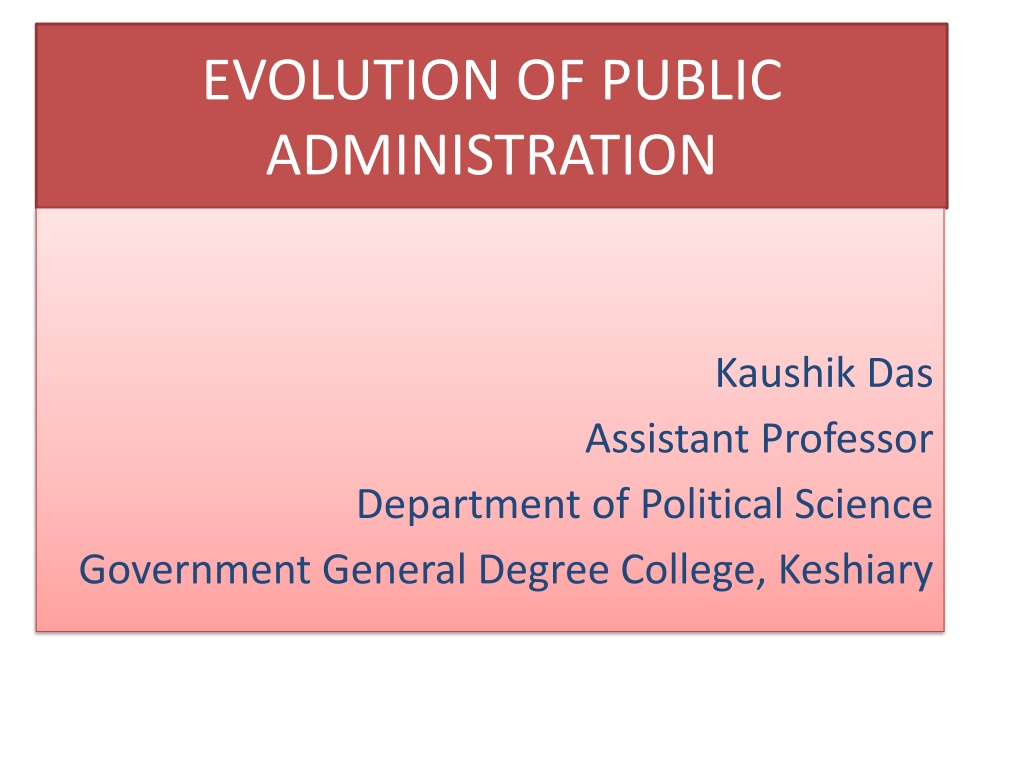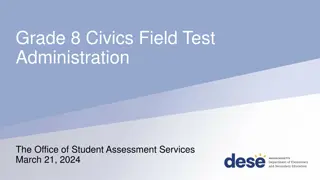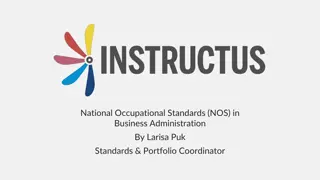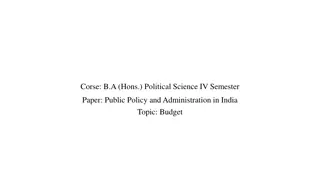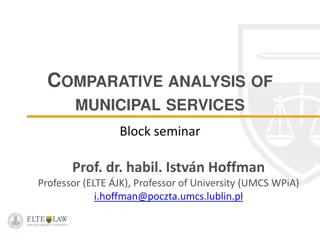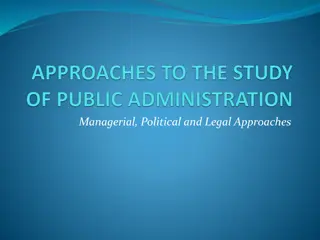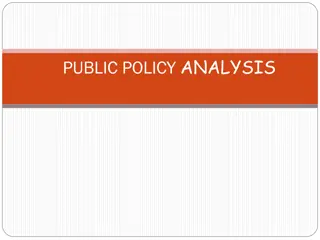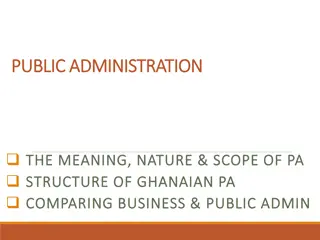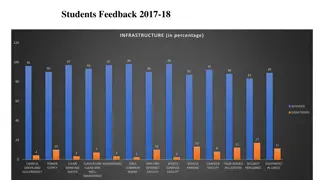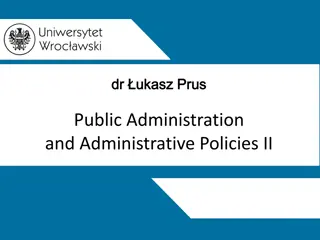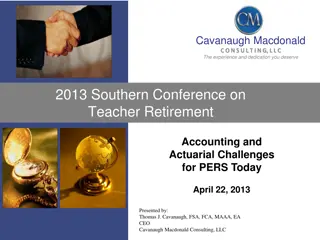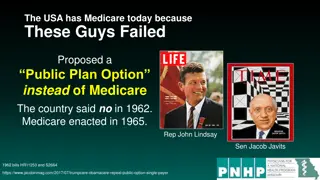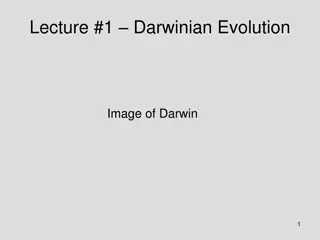Evolution of Public Administration: A Historical Overview
Public administration has evolved through distinct stages, starting from Woodrow Wilson's concept of the politics/administration dichotomy in 1887 to the development of principles in the 1920s and facing challenges of identity crisis in the mid-20th century. The field has transitioned from viewing administration as a separate discipline to incorporating elements of political science and management, ultimately shaping modern practices and theories of public administration.
Download Presentation

Please find below an Image/Link to download the presentation.
The content on the website is provided AS IS for your information and personal use only. It may not be sold, licensed, or shared on other websites without obtaining consent from the author. Download presentation by click this link. If you encounter any issues during the download, it is possible that the publisher has removed the file from their server.
E N D
Presentation Transcript
EVOLUTION OF PUBLIC ADMINISTRATION Kaushik Das Assistant Professor Department of Political Science Government General Degree College, Keshiary
WHAT IS PUBLIC ADMINISTRATION? Public Administration generally means service to the people rendered by a government agency. It is the result of evolutionary process which can be viewed from two distinct perspectives as an activity and as a subject of study or intellectual discipline. In 1887, Woodrow Americans to a administration, with an essay titled, The study of Administration . Wilson new introduced field, public
STAGES OF PUBLIC ADMINISTRATION The evolution of public administration as a separate discipline can be traced in the following phases. The Politics/Administration Dichotomy (1887 1926) Principles Of Public Administration (1927 1937) The Challenge (1938 1950) The Crisis Of Identity (1950 1970) Public Administration As Political Science (1950 -1970) Public Administration As Management (1950 1970) Public Administration As Public Administration (1970 Present)
1STSTAGE THE POLITICS/ADMINISTRATION DICHOTOMY (1887 1926) Woodrow Wilson led the first stone of a new discipline in 1887 with the ideas of development of science of administration and separation between politics and administration . However, Wilson did not draw a clear line between the politics and the administration. It was in 1900, when Frank J. Goodnow (known as father of American public administration) separated politics and administration. He wrote in his book, Politics and Administration Politics has to do with policies or expressions of the state will, while administration has to do with the execution of these policies.
CONTD According to scholars of this era, separation between politics and administration was necessary so that elected holders and appointed public administrators could work together more effectively as civic leaders. In 1926, L. D. White in his book, Introduction to the Study of Public Administration expressed that; Partisan politics should not intrude on administration; the mission of public administration administration in general is capable of becoming a value- free science in its own right. This perspectives provided an intellectual base for the next phase of public administration which focused on the idea that like principles of science, there were principles of administration. is efficiency; and
PRINCIPLES OF PUBLIC ADMINISTRATION (1927 1937) In 1927, W. F. Willoughby wrote in his book, The principles of Public Administration that Public administrators would be effective if they learned and applied scientific principles of administration. This suffused the whole management theory into public administration which proved poison for newly born field, public administration. Mohit Bhattacharya writes during this period, focus of public administration replaced almost wholly by efficiency . from public was
CONTD Advocates of the principles approach believed in:- Universality Of administrative principles which could be applied to all sorts of organization anywhere regardless of culture, institutional framework, mission etc. Principle approach would promote efficiency and economy in administration. However, in 1935, Princeton University hosted a national conference where it was found that public administration could not be established as separate field of study within the universities. administrative environment, setting, function,
THE CHALLENGE (1938-1950) During this phase, both the first and the second phase were challenged. It was objected that- Politics and administration could never be separated clearly because in practice, there is close nexus between politics and administration. In 1950, a scholar wrote, A theory of public administration means in our time a theory of politics also. And hence, Nicholas Henry says, With this declaration, the dichotomy died.
CONTD Principles something big enough. Herbert Simon and Robert Dahl were in support of the above two objections. In 1947, Herbert Simon in his book, Administrative Behavior wrote that A fatal defect of the current principles of administration is that principle one can find an equally plausible and acceptable contradictory principle. of administration were not for almost every
CONTD In Simon s conclusion, principles are unscientifically derived and no more than proverbs. He also rejected separation between politics and administration and argued for logical positivism in the study of policy- making and relation of means and ends. He observed that decision-making derived from the logic and psychology of human choice. must be
CONTD While Robert Dahl in his essay, The Science of Public Administration problems in the evolution of science of public administration Exclusion of normative consideration from public administration. Exclusion of the study of human behaviour from the science of public administration. expressed three
CONTD Exclusion of the varying historical, sociological, economic & other conditioning factors from the science of public administration. By 1950s, both the completely rejected by scholars of public administration. This rejections left public administration without identity, and thus a new phase of evolution of the discipline of public administration took birth. objections were
THE CRISIS OF IDENTITY (1950-1970) PUBLIC ADMINISTRATION AS POLITICAL SCIENCE (1950-1970) In this phase, public administration was re- established into the mother discipline, political science. But there were several issues such as- Absence of comprehensive framework for public administration as a separate discipline. And willing of political scientists to engulf public administration into political science. intellectual
CONTD. So observers rightly commented that public administration stands in danger of senescence, and that lusty young giant of a decade ago, may now evaporate as a field. During 1960s, the American Association moved officially to rid itself of public administration. So, a scholar pointed that political science seems to have less utility in the education of public administrators. Political for intellectualized understanding administration, whereas educates for knowledgeable action . Political Science science educates public of public administration
PUBLIC ADMINISTRATION AS MANAGEMENT (1950-1970) As public administration was struggling for its identity, a few public scholars began searching for an alternative. They found it in management , called either administrative science or generic management , which holds that sector, culture, institution, mission, so on and consequence to efficient administration, and that a body of knowledge statistics, economics, research, and organization are often needed, and exists common to the field of administration. so forth have little and effective accounting, operation
Contd.. But it is noteworthy that management s focus is exclusively technical, whereas public administration s focus is both technical and normative. Finally, it was becoming increasingly clear to public administration s scholars that neither political science nor management addressed their interest, nor could they. With this, a new phase began.
PUBLIC ADMINISTRATION AS PUBLIC ADMINISTRATION (1970-PRESENT) In 1970, public administration declared as an independent discipline with the birth of National Association of schools of Public Administration (NASPAA). Finally, according to recent research, pioneering of public administration were right on several important counts such as Professional public administration improves administrators and politicians work in team to fulfil the public interest, even though elected politicians and appointed administrators do different things, etc. governance, public
CONTD In the late 1980 s New Public Management (NPM) theory advocated by David Osborn and Ted Gaebler in their Government emphasized the use of private society style models, organizational ideas and values to improve the service and service orientation of the public sector. It treated individuals as customers or clients , rather than as citizens. book Reinventing
